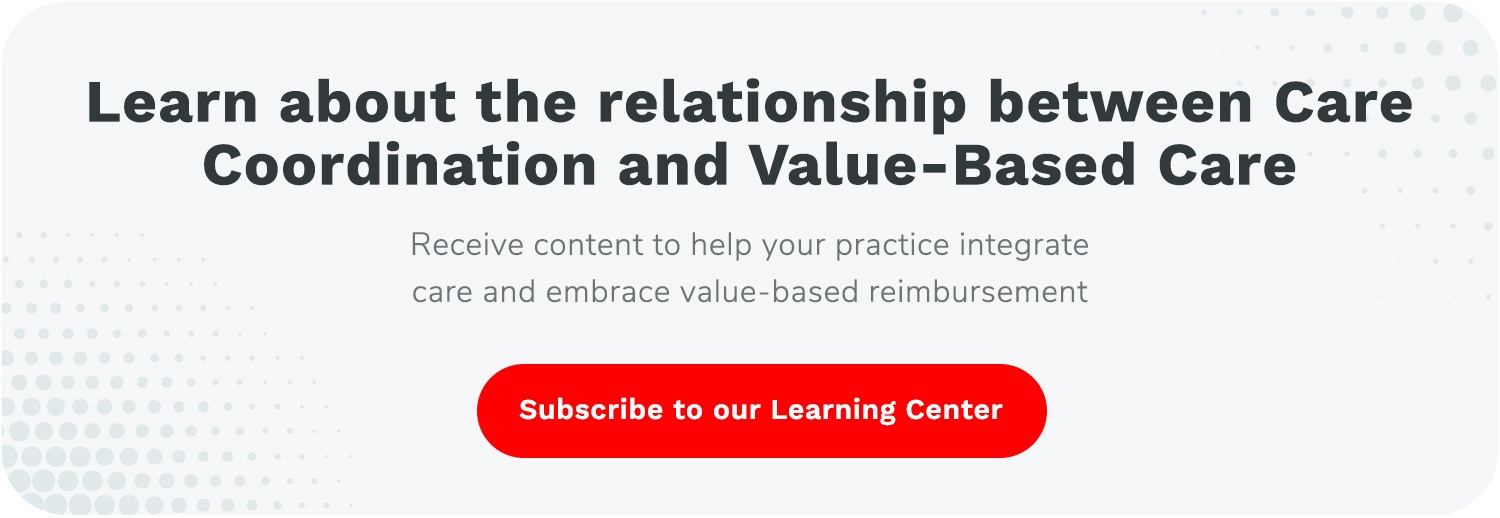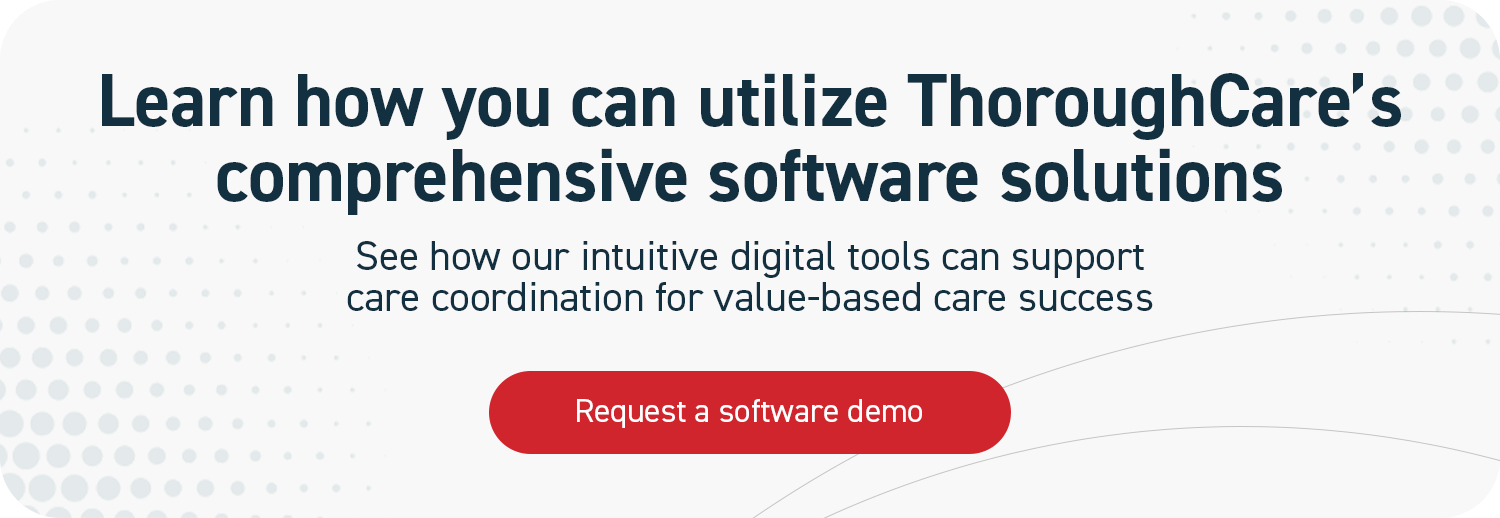Transitional Care Management | Value-Based Care
Implementing Value-Based Care With Transitional Care Management (TCM)
Implementing value-based care can help providers improve patient health and reduce care costs, but it has introduced new, overwhelming challenges to physician practices.
For example, private insurers and Medicare now use alternative payment models, such as the Hospital Readmissions Reduction Program (HRRP), to promote value-based care.
In this or similar arrangements, providers find that they could miss reimbursement opportunities or be penalized if they fail to meet or exceed specific performance metrics. These metrics can include patient engagement, health outcomes and readmission rates, and clinical efficiency.
This shift in reimbursements has made the healthcare industry apprehensive about an overall transition to value-based care. A lack of specificity about how to actually implement this new model has made the matter more difficult.
Care coordination offers a broad strategy to address the referenced metrics and transition to value-based care. But specific care management programs can offer a more exact method to pursue change.
Transitional Care Management (TCM), a program overseen by Medicare, is one example. The program emphasizes communication and coordination to better manage patient care transitions. It can be used to reduce the likelihood of readmission after a hospital discharge.
At ThoroughCare, we’ve provided digital care coordination solutions to clinics and physician practices across the US. We’ve helped many of these groups establish TCM programs to improve patient engagement, enable better health, and maximize clinical efficiency.
In this article, we’ll review what TCM is, as well as cover three core areas where the program can help your practice implement and transition to value-based care.
What is Transitional Care Management (TCM)?
TCM is one of several care management programs offered by Medicare. As a provider, you can use it to manage your patient’s transition from acute care to a post-acute setting, such as their home. The primary goal of a transitional program is to prevent hospital readmission.
Coordinated care services can play an important role at this critical time. Patients can be more vulnerable to health complications. That’s why TCM is specifically focused on the first 30 days after a patient exits the hospital. Patients can only be enrolled in TCM for this duration. To qualify for the program, a person must be discharged from one of the following settings:
- Inpatient acute care hospital
- Inpatient psychiatric hospital
- Long-term care hospital
- Nursing home
- Inpatient rehabilitation center
- Hospital outpatient observation/partial hospitalization
Primary care doctors and specialists, as well as non-qualifying medical practitioners, may offer TCM services. This consists of three segments. They are interactive contact, non-face-to-face services, and office visit. Each segment occurs within a specific timeframe throughout the program’s 30-day run. Unless determined to be unnecessary, all segments are mandatory within their specified timeframe.
To learn more about the specifics of each of these segments, refer to the following graphic:

Providers can be reimbursed for offering transitional services using CPT codes 99495 and 99496. Rates vary depending on the complexity of care supported and the provider's location. Please search the Physician Fee Schedule from CMS for the latest information.
3 Ways That TCM Enables Value-Based Care Success
A transitional care program can help your practice address specific performance areas that are relevant to value-based care. Below, we’ll review three of these, so you have a better sense of how exactly TCM can help you implement and transition to this new care model.
1. Improve Patient Satisfaction and Engagement
Value-based care emphasizes creating a satisfying patient experience. It aims to provide a more transparent, valuable exchange in a world where most everyone finds their healthcare complicated and costly.
Patient engagement is important to value-based care because it can influence health outcomes, especially when it comes to transitional care. According to a study by researchers at the University of Pittsburgh, patient engagement that centers on hospital discharge interventions and planning can reduce readmissions by 25% in the first 90 days.
TCM prioritizes this exact type of engagement.
The three segments of the program automatically facilitate communication and instruction. Each service component revolves around contacting your patient to discuss health status, manage medications, establish or adjust interventions, and coach patients through self-care instructions.
Other means of patient engagement through a transitional care program can include:
- Helping the patient identify and communicate with necessary agencies, health resources, and community services
- Educating the patient and necessary non-clinical care team members (such as the patient’s family or caregiver) in areas including independent living and ADLs
- Assisting patients and/or non-clinical care team members in accessing care services
Time intervals that govern each service segment also help engage your patient throughout the first month of their hospital discharge. TCM is structured to provide timely patient communication touchpoints, rather than lumping all service offerings into a single interaction.
For instance, initial contact must occur within two days of leaving the hospital. An in-person office visit must follow, within seven to 14 days of discharge. This can benefit your patient by keeping them focused on their recovery, and help them plan for further post-acute care, throughout their transition home. This can support a continuum of care that can enable better health, overall.
2. Reduce Readmissions and Enable Better Patient Health
HRRP is a value-based care purchasing program implemented by Medicare. It ties provider payment to hospital readmission reduction. The program requires data reporting to show progress and justify reimbursement. If your practice fails to keep its patients out of a critical care setting, your revenue can take a hit.
A transitional care program can go a long way toward minimizing your exposure to HRRP’s penalties. According to the American Journal of Medical Quality, patients decreased their odds of hospital readmission by nearly 87% when they participated in TCM.
We covered how the program can engage your patients in the section above. This engagement can enable improved health outcomes by aligning patients and care teams while supporting patient self-care at a critical time.
TCM can help connect patients and caregivers to outpatient services or community resources and facilitate adjustments to care instructions and interventions as recovery occurs. Also, TCM can help introduce patients to other care management solutions that can support chronic disease or behavioral health management.
These can include Chronic Care Management (CCM) and Behavioral Health Integration (BHI). Both solutions further support a patient’s continuum of care in a post-acute setting. And both have been shown to help improve overall health. CCM, specifically, can help lead to fewer hospitalizations and emergency room visits.
These benefits naturally support the goal of a transitional care program, aid in readmission reduction for HRRP reporting, and encourage clinical efficiency.
3. Maximize Clinical Efficiency
With a TCM program, your practice can engage and treat a high volume of patients mostly remotely. All points of engagement occur via phone or telehealth platforms, except for the in-office visit. Without overlying on office visits, though, your practice can regularly support a continuum of care and close clinical gaps.
More importantly, TCM does not require full-provider time. Your staff, who is most often represented by a care manager, can perform nearly all of the tasks required for the program, except the in-office visit. On average, a care manager may be able to engage 100 to 250 patients per month. This range is based on feedback from providers who offer TCM services.
Software solutions can further streamline TCM.
Task automation, scheduling tools, and health data integration can increase your practice’s capacity and help reduce your staff’s workload. With an analytics platform, health data becomes more easily reportable, which can support how you address and share value-based care performance metrics. Analytics can also help identify operational gaps in your practice, which can impact how a TCM program is managed.
Finally, TCM reimbursements can help your practice establish a new source of revenue. Reductions in hospital readmissions can also enable savings. Both can help expand capacity in other areas of your practice or support the adoption of new technology to further increase efficiency.
Implement Value-Based Care With TCM
Value-based care revolves around general quality performance metrics, such as patient engagement, treatment effectiveness, and clinical efficiency. But it presents you and other providers with a challenge, in that you’re asked to meet these expectations without a clear-cut way to do so.
Missing the mark could mean that your practice fails to maximize reimbursement opportunities or is penalized.
A transitional care program can help your practice meet the performance metrics underlying value-based care. The program can also help your practice adapt to reimbursement challenges, and drive revenue.
But what exactly are the reimbursement rates for TCM?
Medicare supports several CPT codes for this care management solution, but it’s important to know which of them best applies to the level of care you provide. Learn more about billing requirements and reimbursement rates for TCM to understand the program’s revenue potential.
Digital software solutions are available to help your practice embrace integrated, coordinated care through a transitional care program. At ThoroughCare, we’ve designed our care coordination software for easy clinical use with an intuitive interface that allows you and your team to engage patients through multiple care management programs.




